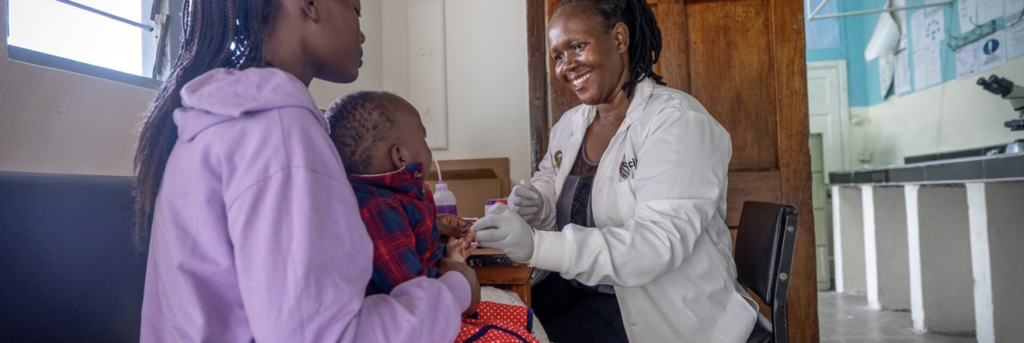Reinvigorated global efforts needed to curb rising malaria threat
Equitable access to life-saving malaria tools key to reversing trend

Elizabeth takes her daughter Prince Angel to the Railway Health Clinic in Kisumu, Kenya, to be tested for malaria.
GENEVA, Switzerland, 12 December 2024 – /African Media Agency (AMA)/ – An estimated 2.2 billion malaria cases and 12.7 million deaths have been averted since 2000, new data from the World Health Organization (WHO) shows, but The disease remains a serious global health threat, particularly in the WHO African Region.
According to the latest WHO world malaria reportIt is estimated that there will be 263 million cases and 597,000 malaria deaths worldwide in 2023. This means there will be about 11 million more cases in 2023 than in 2022, while the number of deaths will be almost the same. Approximately 95% of deaths occur in the WHO African Region, where many at-risk groups still lack access to services needed to prevent, detect and treat the disease.
“No one should die from malaria; yet, the disease continues to disproportionately harm people in the African region, especially young children and pregnant women,” said WHO Director-General Dr. Tedros Adhanom Ghebreyesus. “Expanded life-saving tool kits now better prevent the disease, but greater investment and action in high-burden African countries is needed to curb this threat.”
Many countries have made significant progress
As of November 2024, 44 countries and 1 region Already certified malaria-free by the World Health Organization, many more countries are making steady progress towards this goal. Of the 83 malaria-endemic countries, 25 now report fewer than 10 malaria cases per year, up from four countries in 2000.
Malaria mortality rates in the WHO African Region have also fallen by 16% since 2015. However, the projected mortality rate in 2023 is 52.4 deaths per 100,000 people at risk, still more than double the World Health Organization’s target level of 23 deaths per 100,000 people. Global malaria technical strategy 2016-2030and progress must be accelerated.
Earlier this year, health ministers from 11 African countries (Burkina Faso, Cameroon, Democratic Republic of the Congo, Ghana, Mali, Mozambique, Niger, Nigeria, Sudan, United Republic of Tanzania) that account for two-thirds of the global malaria burden and Uganda) signed a declaration pledging to sustainably and equitably reduce the disease burden and address underlying causes through actions such as strengthening national health systems, enhancing coordination and ensuring strategic use of information.
Wider access to effective tools brings new hope
In addition to strengthening political commitment, wider deployment of WHO-recommended tools is expected to drive further progress in malaria-endemic countries. As of December 2024, 17 countries have introduced malaria vaccines through routine childhood immunization. The continued expansion of vaccinations in Africa is expected to save tens of thousands of young lives every year.
New generation bed nets offer better malaria protection than pyrethroid-only nets and are becoming more widely available, supporting efforts to combat mosquito resistance to pyrethroids. These new bed nets will account for 78% of the 195 million bed nets delivered to sub-Saharan Africa in 2023, up from 59% in 2022.
Funding remains a major obstacle to future progress
Global funding for malaria control remains insufficient to reverse current trends, especially in high-burden African countries. In 2023, total financing is expected to reach US$4 billion, far below the full-year financing target of US$8.3 billion set by the global technology strategy. Insufficient funding has led to huge gaps in coverage of insecticide-treated bed nets, medicines and other life-saving tools, especially for those most vulnerable to the disease.
In addition to funding, malaria-endemic countries continue to grapple with fragile health systems, weak surveillance, and growing biological threats such as drug and insecticide resistance. In many regions, conflict, violence, natural disasters, climate change and population displacement are exacerbating already widespread health inequalities faced by people at high risk of malaria, including pregnant women and girls, children under 5 years old, indigenous peoples, migrants, crowd. People with disabilities and people in remote areas with limited medical services.
Closing gaps in malaria care through equity-focused action
this year’s world malaria report Emphasizing the need for a more inclusive and effective response that reaches those most vulnerable to the disease. WHO urges countries to prioritize primary health care as the foundation for equitable and efficient health systems. Countries are encouraged to adopt strategies to address the root causes of malaria by addressing gender inequalities and other determinants of health.
WHO also calls for investment in robust data systems that can monitor health inequalities, including through the collection and analysis of data disaggregated by sex, age and other social classes. Equity, gender equality and human rights should be the cornerstone of antimalarial innovation, involving those most affected by the disease in the design and evaluation of new tools and approaches.
Distributor African Media Agency (AMA) On behalf of the World Health Organization.
Post Revitalized global efforts needed to curb growing malaria threat first appeared in african media agency.


